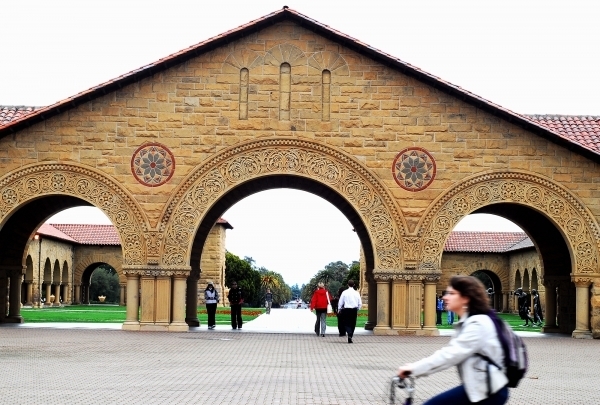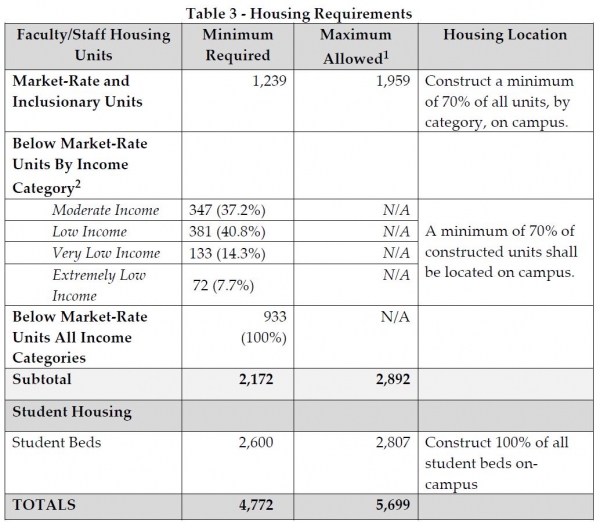Stanford University would have to build more than 2,000 housing units for staff and faculty, and to offer nearly half of them at below market rate, to secure permission for its ambitious campus-expansion plan under conditions that Santa Clara County released Wednesday afternoon and that Stanford is vigorously challenging.
The conditions, which will be reviewed by the county's Planning Commission over the next month, are a critical component of the county's environmental-review process for Stanford University's growth plan. In its application for a general-use permit, Stanford had requested the county's permission to build 2.275 million square feet of academic space, 3,150 housing units (which includes 2,600 student beds), and 40,000 square feet of support space, including child care facilities and trip-reducing facilities, by 2035.
If the county Board of Supervisors approves the conditions, Stanford would have to construct roughly four times as many housing units (not including student beds) than the 550 it had proposed. In addition to the 2,600 student beds, the university would also have to construct at least 2,172 units, of which 1,239 would be offered at market rates. Stanford would be required to offer the remaining 933 units at below-market rate, with a set amount for each income category.
Furthermore, at least 70 percent of the new housing units would have to be built on campus. The rest would have to go up within 6 miles of the campus, unless the county Planning Commission deems this requirement "infeasible" and agrees to grant Stanford an exception.
These housing units would have to be constructed concurrently with new classrooms, labs and other academic facilities. The conditions call for Stanford academic development to be split into four phases, each consisting of 25 percent of the 2.275 million square foot maximum. In each phase, Stanford would be required to build the required proportion of housing in each category, such that a quarter of the required housing would have to completed before Stanford can move into the second phase of construction of its academic buildings.
The vast majority of the 933 below-market-rate units would be devoted to moderate- and low-income households (347 and 381 units, respectively). Stanford would also be required to build 133 units in the "very low income" category and 72 in "extremely low income" category.
The county would also allow Stanford to avoid constructing some of these units by paying housing impact fees and earning "credits" from the county to satisfy the affordable-housing requirements.
The county's newly released conditions also call for some changes to the "no net new commute trips" program that was introduced in the 2000 general-use permit and that has driven Stanford to greatly reduce the rate of solo commuters arriving and leaving campus during peak hours. In addition to considering trips during the peak hour in the morning and afternoon, the new proposed program would also consider Stanford's traffic impacts during a three-hour "peak period."
Under the county's proposed program, a violation would occur if the average annual traffic counts for the peak hour – or the peak period – exceed the baseline level by 1% or greater during any year. If this happens, the county would immediately suspend approval of any new development projects until Stanford demonstrates compliance for at least a year.
The county also plans to impose a new standard for reverse commutes. Stanford will be required to implement "all feasible measures" to achieve no net increase in reverse commute trips during peak commute times. And Stanford would get penalized if commute trips exceed the baseline by 2% or more in the second phase of the development plan.
Another condition focuses on average daily trips to and from the Stanford campus. During and after the second phase of the campus expansion, Stanford would have to ensure that its average daily trips do not increase by 3% or greater in any two consecutive years. If the standard is violated, the county would not approve the next development phase.
The proposed conditions would also require Stanford to make contributions to surrounding communities for transportation and recreation improvements. This includes $450,000 for Clark Avenue and Newell Road connections in East Palo Alto; $250,000 for bicycle improvements at Bol Park in Palo Alto; $250,000 for the Oak Grove Avenue connection in Menlo Park; and $250,000 for improvements at Santa Cruz Avenue and Alameda de Las Pulgas in unincorporated San Mateo County.
Under the proposed conditions, Stanford would also contribute $375,000 for park improvements in Palo Alto, including tennis court upgrades at Terman Park and Weisshaar Park and playground improvements in Cameron Park. And if it goes beyond the minimum requirements and builds more than 4,425 housing units, Stanford would be required to pay for the replacement of turfs at Heritage Park in Palo Alto and at Stanford Hills Park in Menlo Park.
The proposed changes, released in a 125-page document, are not entirely unexpected. In March, county staff released a one-page summary of its proposed conditions, which included the new number of housing units. County officials see the additional housing as a needed mitigation for the additional 9,610 people that Stanford's expansion would attract. Last summer, county staff released an environmental analysis of two housing alternatives to the university's application, each of which included far more units than Stanford had proposed.
Supervisor Joe Simitian noted during a March 14 meeting that Stanford's proposal falls well short of what's needed to house the growing Stanford population. The math, he said, is "pretty simple."
"I don't think 550 units of housing (proposed by Stanford) is sufficient to address the housing need of those 7,010 folks who are left over, after we remove the (student) beds," Simitian said. "That has been a source of discussion from almost day one with respect to the proposal."
Stanford, for its part, has vociferously opposed the change and requested earlier this month that the Planning Commission delay its review. Catherine Palter, Stanford's associate vice president, cited the summary in her May 9 letter to the county, in which she suggested that the conditions are steering the planning process toward "a permit that Stanford cannot accept."
Palter also suggested that the additional housing demanded by the county would result in "significant detrimental environmental impacts to our neighbors and would impair Stanford's use of its academic space."
The summary of conditions, she wrote, "calls for transforming a college campus into an urban apartment complex."
"At the end of the day, a permit will be valid and effective only if the applicant views the comprehensive project as feasible and accepts the permit," Palter wrote. "An applicant will not elect to build a project under conditions that the applicant considers to be unworkable. Stanford is no different from other applicants in this respect."
Stanford is also still hoping to reach a development agreement with county – a negotiated contract that would allow each party to go beyond state requirements and propose further community benefits and development conditions. Earlier this month, the university published a "frequently asked questions" page stating that an agreement would "provide certainty over the long term about the total package of community benefits that will be provided as development occurs on the Stanford campus."
Jessica von Brock, Stanford's director for land use and planning, made a similar point on May 9, during a study session of the county's Planning Commission.
"With a development agreement, Stanford can safely guarantee its financial commitments to schools, to housing development and transportation projects and promise contributions to partners that are not otherwise under the county's direct control," von Brock said.
Von Brock was responding to the suspension of development agreement talks by the county on April 15 after Stanford and the Palo Alto Unified School District had announced they'd struck a deal in which Stanford would provide about $138 million in benefits to the school system. That deal, however, was contingent on the county approving its development agreement – a condition that Simitian told the Weekly he found unacceptable because of the pressure it put on the county.
On Wednesday, Stanford issued a statement reasserting its position that the county's proposed conditions of approval are not sufficient in providing the kinds of community benefits that neighboring jurisdictions and the Palo Alto school district have requested from Stanford.
"A development agreement is the appropriate tool for providing these benefits, and we believe Santa Clara County should delay taking action on the Conditions of Approval and engage with Stanford in comprehensive development agreement discussions," the statement reads. "The regulatory certainty provided through a development agreement will enable the university to provide additional community benefits. Stanford is ready and willing to engage in talks with the County."
Despite Stanford's request that the planning commission delay its review of the conditions of approval until it has a development agreement at hand, county officials the next day decided that the hearings on the conditions of approval should proceed as planned.
The first of these will be held at 6 p.m. on May 30 in the Council Chambers at City Hall. The second and third will be held at 1:30 p.m. on June 13 and June 27 in Isaac Newton Senter Auditorium at County Government Center, 70 W. Hedding St., San Jose.
Related content:
• Stanford, county supervisors give conflicting accounts of talks to restart negotiations




Comments
Registered user
Old Mountain View
on May 29, 2019 at 7:12 am
Registered user
on May 29, 2019 at 7:12 am
As the article states, Stanford would be able to build 30% of its housing requirements off campus within 6 miles of the academic campus. Obviously, that includes a big chunk of Mountain View. Since few people (spouses of students, faculty, and staff) would be able to work in Mountain View and live at Stanford, this would aggravate the impact of our jobs-housing imbalance, though it wouldn’t necessarily show up in statistics.
Sylvan Park
on May 30, 2019 at 1:23 pm
on May 30, 2019 at 1:23 pm
The county proposes to require housing to match the added population at Stanford except that 30% could be built within 6 miles. Why not on campus? It is a big campus. How about requiring twice the housing proposed by the county - all on campus? That way, more Stanford students and employees can live there and create less of a burden on surrounding communities. While the City of Maintain View has not practiced what last year's mayor seems now to be preaching to the county in his post above, it is time for major changes. The state government is in the process of enacting laws that will prescribe high-density housing across cities such as Palo Alto, Los Altos and Mountain View. The most imposing proposed law (SB 50) is on temporary hold. But other bills are on track for passage.